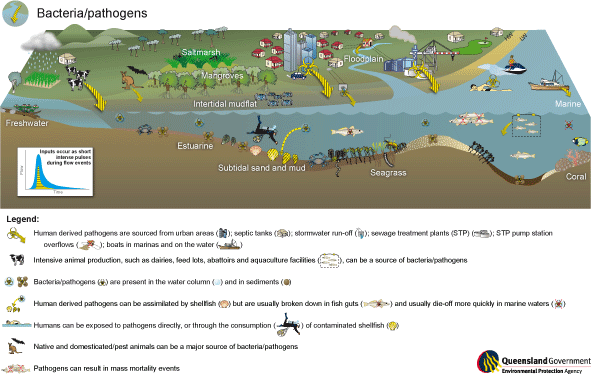Our current best conceptual understanding of the stressor ‘bacteria/pathogens’ is shown in Figure 1.
Figure 1. Potential causes of a change to bacteria/pathogens and the condition responses observed as a result of this change.
Pathogens include bacteria, viruses, protozoans and fungi, and are causative agents of disease. Unsafe densities of pathogens in coastal waters can lead to restrictions on shellfish harvesting, fish kills and if ignored or unnoticed, to health problems in humans and other organisms.
An example of a pathogenic disease affecting fish assemblages is epizootic ulcerative syndrome. Low-pH increases the susceptibility of fish to this fungal disease.
Some pathogens occur naturally in marine waters. Others are carried into waterways after defecation/urination/shedding from human or animal hosts (e.g. via sewage effluent, agriculture and stormwater run-off, sewage from ships, recreational population using the water, industrial processes, wildlife, septic tanks near the shore and urban development) (WHO, 2001a). Rivers discharging into coastal areas may carry abundant micro-organisms from these diverse sources. High concentrations of pathogens usually occur after storms due to surface run-off, sediment re-suspension and because rainwater gets into sewerage pipes through faults and illegal connections and causes sewage to overflow. Contamination from human sources (e.g. faecal pollution) presents a greater risk to humans than contamination from animal sources because many animal pathogens are not infectious to humans. Risks to humans from pathogenic organisms are higher in areas with large population densities or with a significant tourism, and are perhaps best assessed by the volume of stormwater and coastal discharges indicators.
Different pathogen-indicator organism relationships may exist between saline and fresh waters, so the same level of faecal indicator bacteria in freshwater and marine environments does not mean the health risk is the same (WHO, 2001b).



